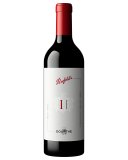Penfolds The Max Schubert Cabernet Shiraz
The Max Schubert Cabernet Shiraz is testament to Penfolds' winemaking philosophy and the art of multi-regional blending. A wine with great complexity and length, which combines the intense red fruits with leathery oak and savoury tannins. This Penfolds will drink beautifully now yet it also has the structure for careful cellaring.
Penfolds Dourthe
The creation of this limited release cabernet shiraz began in a quest to create something real, different, and aspiringly lofty, together with our trusted partner Dourthe Bordeaux. The French component of this wine was made at two of the Dourthe-owned wineries. Australian components of this wine were made at Penfolds Nuriootpa Winery (South Australia). The French and Australian components were blended and bottled in South Australia.
Penfolds Dourthe CabMerlot Non-Vintage
The French component of this wine was made at two of the Dourthe-owned wineries. Australian components of this wine were made at Penfolds Nuriootpa Winery in South Australia. Both components were blended and bottled in South Australia for a truly one-of-a-kind release.
Penfolds Dourthe Cabernet Sauvignon
Since 1844, Penfolds has been grounded in experimentation, curiosity and uncompromising quality. This pioneering spirit still rings true after nearly two centuries and is what has helped them become one of the most celebrated winemakers in the world today. The creation of this limited release Cabernet Sauvignon began as a quest to create something real, different, and aspiringly lofty, together with our trusted partner Dourthe Bordeaux. The French component of this wine was made at two of the Dourthe-owned wineries. Australian components of this wine were made at Penfolds Nuriootpa Winery (South Australia). The French and Australian components were blended and bottled in South Australia. A natural match with lamb studded with rosemary and thyme. Slow braised beef cheeks. Cheese: English cheddar, Grana Padano, Limburger.
Penfolds 65F By NIGO Cabernet Sauvignon Shiraz
Introducing 65F by NIGO. The iconic Penfolds chimney, re-imagined by NIGO. Inspired by the metal chimney which towers 65 feet over Penfolds Magill Estate Winery, NIGO revived material from our archive to inspire the design. Included in the gift box is a wine tag with a chalk pencil, taking inspiration from the chalk boards in the original working winery at Magill, and a chimney smoke wine stopper as a playful nod to the original purpose of the Magill estate chimney.
Penfolds Bin 149 Giftbox Nappa Valley Cabernet Sauvignon
Penfolds Bin 149 Cabernet Sauvignon seeks out Northern Hemisphere excellence via meticulous vineyard and block selection, reinforced by flagship-worthy South Australian cabernet sauvignon. The result is distinctive, and of distinction. Bin 149’s name is derived from the percentage of South Australian cabernet sauvignon synergistically woven into the blend. Napa Valley regional sourcing seeks to showcase strong tannic foundations, dark fruit intensity but with the added dimension of a unique “worldly” disposition. Matured in French and American oak, this release highlights Penfolds commitment to quality and winemaking approach.
Penfolds Superblend 802A & 802B Cabernet Shiraz
Uncork a captivating exploration of the iconic Australian blend. The 802A offers a robust symphony of blackcurrant, dark plum, and rich mocha, with a profound, muscular palate of concentrated dark fruits and firm tannins. The 802B, in contrast, presents a more perfumed nose of red cherry, subtle spice, and violet, delivering a refined yet equally full-bodied taste with elegant structure and a seamless, lingering finish.
Penfolds Bin 169 Cabernet Sauvignon
Bright plum in colour, Penfolds Bin 169 Cabernet Sauvignon displays delicate notes of mint and blackcurrant, with a more savory bouquet of semi-dried tomatoes and fruit chutney at the end. A hint of oak and spice adds extra warmth. On the palate a flavour-wheel of spearmint, milo powder, chocolate and black liquorice.
Henschke Cyril Henschke
Greenock Creek Roennfeldt Road Cabernet Sauvignon
This tiny vineyard of century old vines produces a wine of formidable structure with an intense Cabernet style of mixed fruits and berries.




















